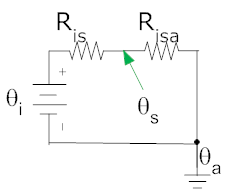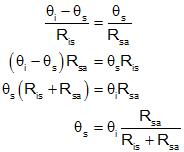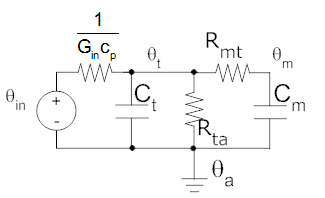Mathematical Models of Thermal Systems
Contents
Introduction
While the previous page (System Elements)
introduced the fundamental elements of thermal systems, as well as their
mathematical models, no systems were discussed. This page discusses how
the system elements can be included in larger systems, and how a system model
can be developed. The actual solution of such models is discussed
elsewhere.
The Energy Balance
To develop a mathematical model of a thermal system we use the concept of an
energy balance. The energy balance equation simply states that at any
given location, or node, in a system, the heat into that node is equal to the
heat out of the node plus any heat that is stored (heat is stored as increased
temperature in thermal capacitances).
Heat in = Heat out + Heat stored
To better understand how this works in practice it is useful
to consider several examples.
Examples Involving only Thermal Resistance and
Capacitance
Example: Two thermal resistances in series
Consider a situation in which we have an internal temperature, θi,
and an ambient temperature, θa with two resistances between
them. An example of such a situation is your body. There is a
(nearly) constant internal temperature, there is a thermal resistance between
your core and your skin (at θs), and there is a thermal
resistance between the skin and ambient. We will call the resistance
between the internal temperature and the skin temperature Ris, and
the temperature between skin and ambient Rsa.
a) Draw a thermal model of the system showing all relevant quantities.
b)
Draw an electrical equivalent
c) Develop a mathematical model (i.e., an
energy balance).
d) Solve for the temperature of the skin if θi,
=37°C, θa =9°C, Ris=0.75°/W; for a
patch of skin and Rsa= 2.25°/W for that same patch.
Solution:
a) In this case there are no thermal capacitances or
heat sources, just two know temperatures ( θi, and θa),
one unknown temperature (θs), and two resistances ( Risand Rsa.)

b) Temperatures are drawn as voltage sources.
Ambient temperature is taken to be zero (i.e., a ground "temperature), all
other temperatures are measured with respect to this temperature).

c) There is only one unknown temperature (at θs),
so we need only one energy balance (and, since there is no capacitance, we
don't need the heat stored term).

Note: the first equation
included θa, but the second does
not, since θa is our reference temperature and is taken to
be zero.
d) Solving for θs

Note: you may recognize this result as the voltage divider equation from
electrical circuits.
We can now solve numerically (we use 28°C for the
internal temperature since it is 28°C above ambient
(37°-9°=28°)

This says that θs
is 21°C above ambient. Since the ambient temperature is
9°C, the actual skin temperature is 30°C.
Note: If Rsa is lowered, for example by the
wind blowing, the skin gets cooler, and it feels like it is colder.
This is the mechanism responsible for the "wind chill" effect.
Example: Heating a Building with One Room
Consider a building with a single room. The resistance of the
walls between the room and the ambient is Rra, and the thermal capacitance of
the room is Cr, the heat into the room is qi, the
temperature of the room is θr, and the external
temperature is a constant, θa.
a) Draw a thermal model of the system showing all relevant quantities.
b)
Draw an electrical equivalent
c) Develop a mathematical model (i.e., a
differential equation).
Solution:
a) We draw a thermal capacitance to represent the room (and note its
temperarature). We also draw a resistance between the capacitance and
ambient.

b) To draw the electrical system we need a circuit with a node for the
ambient temperature, and a node for the temperature of the room. Heat
(a current source) goes into the room. Energy is stored (as an
increased temperature) in the thermal capacitance, and heat flows from the
room to ambient through the resistor.

c)
We only need to develop a single energy balance equation, and that is for the
temperature of the thermal capacitance (since there
is only one unknown temperature). The heat into the room is qi,
heat leaves the room through a resistor and energy is stored (as increased
temperature) in the capacitor.

by convention we take the ambient temperature to be zero, so we end up with
a first order differential equation for this system.

Example: Heating a Building with One Room, but with
Variable External Temperature.
Consider the room from the previous example. Repeat parts a, b, and c
if the temperature outside is no longer constant but varies. Call the
external temperature θe(t) (this will be the temperature
relative to the ambient temperature). We will also change the
name of the resistance of the walls to Rre to denote the fact
that the external temperature is no longer the ambient temperature.
Solution:
The solution is much like that for the
previous example. Exceptions are noted below.
a) The image is as before with the external temperature replaced by θe(t).

b) To draw the electrical system we need a circuit with a node for the
external temperature and a node for the temperature of the room.
Though perhaps not obvious at first we still need a node for the ambient
temperature since all of our temperatures are measured relative to this, and
our capacitors must always have one node connected to this reference
temperature. Heat flows from the
room to the external temperature through the resistor.

c) We still only need to develop a single energy balance equation, and
that is for the temperature of the thermal capacitance (since there
is only one unknown temperature). The heat into the room is qi,
heat leaves the room through a resistor and energy is stored (as increased
temperature) in the capacitor.

(the ambient temperature is taken to be zero in
this equation). In this case we end up with a system with two inputs
(qi and θe).
Example: Heating a Building with Two Rooms
Consider a building that consists of two adjacent rooms, labeled 1 and 2. The resistance of the
walls room 1 and ambient is R1a, between room 2 and ambient is R2a
and between room 1 and room 2 is R12. The capacitance of rooms 1 and 2 are C1 and C2,
with temperatures θ1 and θ2, respectively. A heater in in room 1 generates a heat qin.
The temperaturexternal temperature is a constant, θa.
a) Draw a thermal model of the system showing all relevant quantities.

b)
Draw an electrical equivalent

c) Develop a mathematical model (i.e., a
differential equation).
In this case there are two unknown temperatures,
θ1and θ2, so we need two energy balance
equations. In both cases we will take θa to be zero,
so it will not arise in the equations.
| Room 1: Heat in = Heat out + Heat Stored |
|
Room 2: Heat in = Heat out + Heat Stored |
 |
|
 |
In this case there are two parts to the "Heat Out"
term, the
heat flowing through R1a and the heat
through R12. |
|
In this case we take heat flow through
R12 to (from 1 to 2)
to be an input. |
|
|
We could also take this energy balance
to have no heat in, and write the heat flow from
2 to 1 as a
second "Heat out" term. (note the
change
of subscripts in the subtracted terms)
 |
The two first order energy balance equations (for room 1 and room 2) could
be combined into a single second order differential equation and solved.
Details about developing the second order equation are
here.
Examples Involving Fluid Flow
So far we have not considered fluid flow in any of the examples; let us do so
now.
Example: Cooling a Block of Metal in a Tank with Fluid Flow.
Consider a block of metal (capacitance=Cm, temperature=θm).
It is placed in a well mixed tank (at termperature θt, with
capacitance Ct). Fluid flows into the tank at temperature
θin with mass flow rate Gin, and specific heat cp.
The fluid flows out at the same rate There is a
thermal resistance to between the metal block and the fluid of the tank, Rmt,
and between the tank and the ambient Rta. Write an energy
balance for this system.

Note: the resistance between the tank and the metal
block, Rmt, is not explicitly shown.
Solution:
Since there are two unknown temperatures, we need two
energy balance equations.
| Metal Block: Heat in = Heat out + Heat Stored |
|
Tank: Heat in = Heat out + Heat Stored |
 |
|
 |
In this case there is not heat in, and heat out
is to the
tank through Rmt. |
|
In this case we have heat in from the fluid flow
and from the
metal block.
We have heat out to ambient through Rta. |
Aside: Modeling a Fluid Flow with and Electrical Analog
To model this system with an electrical analog, we can
represent the fluid flow as a voltage source at θin, with
a resistance equal to 1/(Gin·cp). If you
sum currents at the nodes θt and θm you
can show that this circuit is equivalent to the thermal system above.

Solving the Model
Thus far we have only developed the differential equations that represent a
system. To solve the system, the model must be put into a more useful
mathematical representation such as transfer function or state space.
Details about developing the mathematical representation are
here.
References




















